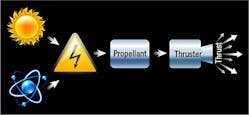This article is part of the TechXchange: Delving into EMI, EMC and Noise.
Members can download this article in PDF format.
What you'll learn:
- EMI effects on spacecraft, radar, communications equipment, and radar, among other applications, and how to minimize them.
- How EMI was handled in a wireless power transfer design.
The phenomenon known as electromagnetic interference (EMI) occurs when any device with electronic circuitry becomes exposed to an electromagnetic (EM) field. The broad electronic spectrum is being used by an ever-growing number of these devices, many of which will have EMI issues affecting their performance.
EMI will lead to poor operation, malfunctioning, and can even ultimately stop circuitry from working at all. Needless to say, system circuit designers need to design their architectures to prevent EMI disturbances that can negatively impact their electronics.
Man-made or even natural EMI sources can be minimized or even blocked with electrical shields. The choice of using higher-quality electronic components can help as well. Error-correction methods may reduce EMI effects, too.
Let’s look at some examples of methods used to prevent, or at least minimize, EMI in electrical/electronic systems.
Spacecraft Electric Propulsion Systems
Most of us are very familiar with NASA’s large rocket engines propelling astronauts into Earth and Lunar orbits, and ultimately landing on the Moon, such as those on the Saturn V. Other powerful engines have been used on rockets that carried supplies and astronauts to the International Space Station (ISS).
Then along came electric propulsion systems (EPS) (see figure).1
Hall-Effect Thruster Technology
All Hall-effect thruster (HET)3 rocket configurations can generate EMI disturbances due to natural plasma oscillations and instabilities to onboard electronic equipment. HETs will emit strong EMI from dc (static electric and magnetic fields) to frequencies above 20 GHz. EMI of the HET completely depends on the type of the thruster used.
Every type of thruster will have a defined operating point, i.e., discharge voltage and discharge current. A difference in operating point within the thrusters will lead to different types of emissions. The discharge current oscillations inside of the Hall thruster will produce both low- and high-frequency emissions.
Adequate shielding techniques must be employed for subsystems, harnesses, and interfaces that will be susceptible in the above-mentioned frequency range. Harnesses located between the power processing and control unit (PPCU) and stationary plasma thrusters (SPTs) need to be routed separately in a shielded jacket, which needs to be grounded at regular intervals, usually at each 100-mm points. Solidly designed power-line filters must be employed between the PPCU and the spacecraft bus to reduce conducted emission noise.
Communications Equipment
- Wireless communications systems: fluorescent lights, mobile phones, and larger sources of interference such as telecom signal facilities at airports and railways, high power electric lines, just to name a few.4
- EMI can degrade intelligibility of voice equipment.
- Analog data can be distorted via EMI.
- Digital data will exhibit bit error rate due to EMI.
Radar
In “Search mode,” EMI will reduce range and probability of detection, which will lead to processor overloads.
In “Tracking mode,” EMI will cause tracking errors and break-lock (this may occur because of a decoy appearing in the resolution cell, causing the radar target tracking to go out of control).
Navigation Systems
Wireless services, such as mobile phones, text messaging, email, web browsing, radio-frequency identification (RFID), and mobile audio/video services, can be a significant source of EMI in passenger aircraft. The FCC and FAA have rules that govern the use of mobile phones and other portable electronic devices (PEDs) on board an aircraft. These safety agencies are charged with facilitating safety for in-flight wireless services.
IFF Systems
EMI can wreak havoc with Identification Friend or Foe (IFF) technologies. These are air-traffic-control recognition systems and devices that have been designed to support operational functions and decision-making; prevent military “friendly-fire” incidents; reduce casualties in the air, on land, and at sea; and detect possible adversary system assault.
EMI in Wireless Power Transfer Designs
Spread-spectrum frequency dithering (SSFD) reduces EMI caused by sharp switching transients for a resonant inverter and rectifier used in wireless power transfer (WPT).5
A magnetic field emission was investigated from a 1-kW-class automotive series-resonant WPT system, which was tuned to 20 kHz for resonance. A triangular modulation profile, having a small modulation index (mf = 1) and modulation frequency (fm = ENBW), could be used to significantly reduce EMI at the harmonic frequencies below 150 kHz with negligible amplitude-modulation (AM) effects on coil currents. Simulation results, leading to a 4.4- to 8.7-dB reduction in the harmonic PSD, can be achieved.
Summary
EMI is a disruption that can affect an electrical circuit due to either electromagnetic induction or externally emitted electromagnetic radiation. It’s the interference, from one electrical/electronic system to another, that’s caused by the electromagnetic fields generated by their operation. This article has shown some examples that designers can use to prevent or minimize EMI disturbances in electronic systems.
Read more articles in the TechXchange: Delving into EMI, EMC and Noise.
References
1. “Study on EMI/ESD effects of Electric Propulsion System on Spacecraft Systems and mitigation techniques,” IEEE 2016.
2. “Approach to EMI Effects of Electric Propulsion,” Thales Alenia Space, Italy.
3. “Electromagnetic Interference with Hall Thruster Operation,” 2004.
4. “How Does EMI Affect Wireless Communications Systems?,” 2019.
5. “EMI Reduction in Wireless Power Transfer System Using Spread Spectrum Frequency Dithering,” IEEE 2016.

